Identification and occurrence of "Eastern" Jackdaws in the Netherlands
Ó
Rudy Offereins
{
Taxonomy and occurrence} { Migration and wintering} {Identification} {Occurrence} {Discussion}Nordic Jackdaws
Corvus monedula monedula. Wijster (Drenthe), 1 February 1998. Note the greyish collars which can appear very light on photographs.
This article first appeared in 1999 in the local bird magazine ‘Taxon’ and is a result of observing Jackdaws at my local patch for three winters, of studying the literature and of a visit to the Zoological Museum in Amsterdam (ZMA). The purpose of this article is to provide insight into the field identification and occurrence of the two races of Jackdaw Corvus monedula spermologus in the Netherlands in the winter season, these two races being Nordic Jackdaw C. m. monedula and Russian Jackdaw C. m. soemmerringii. In most birdbooks these subspecies are hardly mentioned and the information given is often open to interpretation. I do not claim this to be the definite article on this subject, because it is far too complex for that. I welcome additions and/or other opinions.
About names: I do not know if there are official English names for these two races but in this article I will refer to them as Nordic and Russian Jackdaws. Nordic Jackdaw is the direct translation of the name for this race in the Netherlands. I guess Scandinavian Jackdaw would also be suitable but as far as I know there's no consensus about this. I will use (Common) Jackdaw for the race spermologus.
The Jackdaw is separated into three different races, being (Common) Jackdaw Corvus monedula spermologus, Nordic Jackdaw C. m. monedula and Russian Jackdaw C. m. soemmeringii. Voous (1950) and Voipio (1969) consider Nordic Jackdaw to be the westernmost representative of the westerly expansion of the soemmerringii-branch. Shortly put this would mean that Nordic Jackdaw is basically the link between the two best separable races of Jackdaw, being Russian and Common Jackdaw.
Nordic Jackdaw breeds in south-east Norway, the south of Sweden and the northern and eastern parts of Denmark (Cramp & Perrins 1994), with the largest numbers in south and central Sweden (Glutz von Blotzheim & Bauer 1991). In the past Jackdaws occurring in central Europe between c 10° en c 23° E, south to Austria and Croatia were sometimes separated as turrium (e.g. Voous 1950). This race was included in spermologus by some but is nowadays considered to belong to monedula, to which it is closely related and which it resembles most (Cramp & Perrins 1994). This means that the transition zone between spermologus and monedula in Europe covers a broad area from the south of Denmark, north-west Germany and the eastern part of the Netherlands to north-east France and Switzerland.
In south Finland the Nordic Jackdaw slowly integrates into Russian Jackdaw from west to east (Voipio 1969). This transition zone runs from North to South across the Baltic, East Poland to Romania and Croatia (Cramp & Perrins 1994). The actual range of soemmerringii is huge and covers the former Soviet Union to Lake Baikal and north-west Mongolia, south to Turkey and Israel and the Himalaya in the east (Voous 1960, Cramp & Perrins 1994, Madge & Burn 1994).
The Jackdaw is mostly resident. The northern and eastern populations are more migratory. The Russian Jackdaw is a true migrant. First-year birds are more migratory and will wander over longer distances. During migration Jackdaws are often in the company of Rooks Corvus frugilegus (Cramp & Perrins 1994, Voous 1960).
Because of the (west)south-westerly migration in autumn both Nordic and Russian Jackdaws can appear in north-west Europe. Nordic Jackdaws which do migrate in autumn winter mainly in north Denmark, the Benelux countries and north-west France. Finnish Jackdaws winter in north Denmark and the Netherlands (Glutz von Blotzheim & Bauer 1991). Russian Jackdaws winter from their breeding grounds in a south-westerly area across south Sweden to central Europe north of the Alps (Glutz von Blotzheim & Bauer 1991).
The first Nordic Jackdaws appear in the Netherlands in October, with a peak in November. It is likely that Russian Jackdaws appear later because of a longer migration route. In February the first Nordic /Russian Jackdaws leave the Netherlands (Cramp & Perrins 1994, van Dijk & van Os 1982).
General
Before identifying the three races of Jackdaw it is important to judge posture and light correctly. A Jackdaw of the northern race can, when facing the observer, show a much whiter neck-patch than when observed sideways. In bright sunlight a neck-patch can appear much lighter than it really is. This effect is clearly noticeable when such Jackdaws are photographed in bright sunlight, which often produces unreliable pictures. Cloudy weather offers the best conditions for observing and interpreting the characters of eastern Jackdaws.
Moult
Adult Jackdaws of all three races moult their primaries, secondaries and tail from mid May to mid October (Cramp & Perrins 1994), which means that adult birds in winter are in fresh plumage. By the end of March this plumage becomes worn, which can result in a whiter-looking collar. In both races the collar may be absent in the breeding season (Cramp & Perrins 1994, Svensson 1992).
Nordic Jackdaw
Compared to an adult Jackdaw, Nordic jackdaw has a lighter nape and neck-side, which at most can be slightly brighter than in a Jackdaw's breeding plumage, but this is rarely the case. On most adult Nordic Jackdaws the underparts are slightly darker than the nape and neck-side, which is evenly coloured in Jackdaw (Cramp & Perrins 1994). The underparts are plain (pencil-)grey and lighter than on Jackdaw, whose underparts are more black-grey. The black throat of Nordic Jackdaw contrasts much more with the underparts than in Jackdaw. In direct comparison with Jackdaw the lighter underparts of Nordic are a very useful fieldmark. Some Nordic Jackdaws can show evenly grey underparts, nape and neck-side and mantle with contrasting black wings, crown and throat.
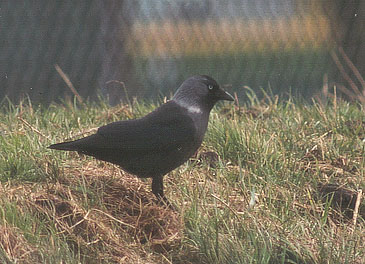
Nordic Jackdaw Corvus monedula monedula. Wijster (Dr), 20 February 1999. Typical adult, with pale-grey nape and neck-side. Underparts hardly darker and more pencil-grey. The throat is contrasting black. The collar is palest in the lower neck and more diffuse in the lower nape (see also picture below).
The most striking character of Nordic Jackdaw is the highly variable (light)grey collar in the lower neck. This collar varies from a vague greyish spot in the lower neck to one that is almost white, followed by a broad silvery and often more diffuse collar in the lower neck. The latter can look almost white in bright sunlight but in the lower neck the collar is never as sharply defined as in Russian Jackdaw (see below). Between these extremes everything is possible. The appearance of the collar depends on the posture of the bird. It is at its broadest when the bird stretches itself and at its smallest (often just a pale line) in a more relaxed posture. Jackdaws with a large diffuse pale spot in the lower neck, a pale nape and neck-side and with paler underparts than Jackdaw may belong to the form turrium, placed in the monedula-group (Cramp & Perrins 1994)
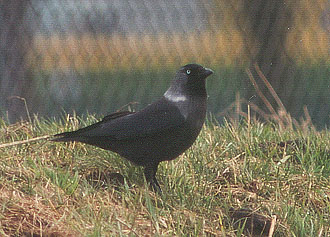
Nordic Jackdaw Corvus monedula monedula. Wijster, 20 February 1999. Another individual. The more spotted and broad (but not bright white!) collar shown here is about the maximum for Nordic.
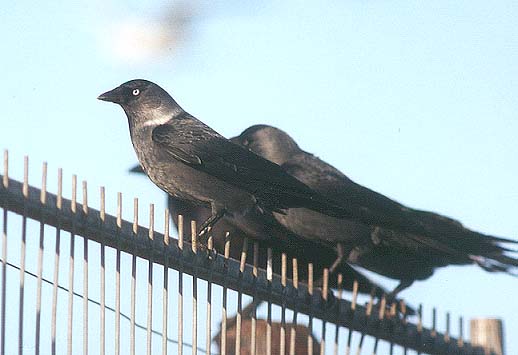
Nordic Jackdaw Corvus monedula monedula. VAM Wijster, 31 October 1999. Very typical adult with a fine silvery collar, (which appears slightly whiter in sunlight) and grey underparts
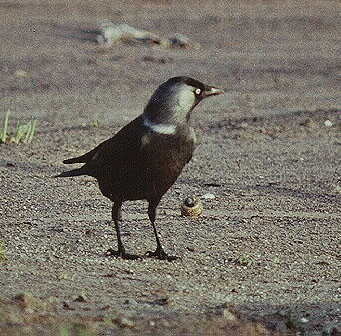
Russian Jackdaw
A well-marked Russian Jackdaw is not difficult to identify. Nape and neck-side are clearly paler than in an adult winter Jackdaw but can be as pale as in the palest Nordic Jackdaw. The nape and neck-side of Russian Jackdaw, however, have a more intense coloration with a vague purple tinge resulting in more contrasting black crown and throat than in Nordic Jackdaw. Underparts are toned black-grey of a tinge between Jackdaw en Nordic Jackdaw (Voous 1960, Cramp & Perrins 1994). All this combined with the white collar results in a very contrasting bird. The collar is always clearly white and sharply defined over its full length. When viewed from behind both collars can appear as one broken white line. In the most extreme Nordic Jackdaws two diffuse grey spots are visible. The collar is about half a centimetre wide in the lower neck and 4-5 cm long.
Russian Jackdaw Corvus monedula soemmerringii. Veendam rubbish-dump (Groningen), date unknown (Picture by Emo Klunder). A contrasting bird. Note the pale nape and neck-side, the almost black underparts and the contrasting bright white collar, which is at its broadest in the lower neck. (see also the picture below).
.
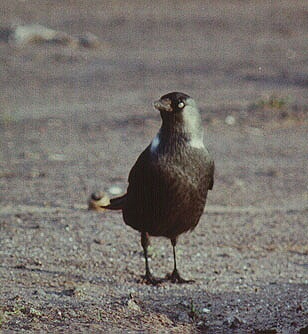
Russische Kauw Corvus monedula soemmerringii. Veendam (Gr.) Picture by Emo Klunder. The throat does not stand out against the belly.
Another Russian Jackdaw can be seen at Teus Luijendijks homepage.
Jackdaw
Adult winter Jackdaw has no pale collar or spot in the lower neck and shows a darker nape and neck-side and underparts than Nordic Jackdaw. As a result of wear Jackdaw may show a narrow pale line in the lower neck in early spring.
First winter birds
Although it is not recommended to identify the races of Jackdaw in first winter plumage (Cramp & Perrins 1994), I would like to make a few remarks.
All races of Jackdaw can generally be identified as 1st winters by their juvenile dull-brown primaries, secondaries and tail whereas adult birds have shiny feathers (Cramp & Perrins 1994, Voous 1960). The fieldmarks to identify the various races in this plumage are more subtle.
Nordic Jackdaw can be told from the almost uniform grey-black Jackdaw by its paler and greyer underparts. Its nape and neck-side-colour resembles that of adult winter Jackdaw and is therefore paler than on 1st winter Jackdaw, resulting in a more contrasting crown and throat. Sometimes a faint collar or neckpatch is visible but this is not always the case (Voous 1960). First winter Russian Jackdaws I studied at the ZMA showed a pale nape and neck-sides, similar to those of adult birds. The tone of the underparts lies between Nordic and Common Jackdaw. None of these birds showed a paler collar. On Jackdaws studied in eastern Finland (Voipio 1969), where the birds are considered to be soemmerringii, 43% of the 1st winter birds showed a faint white collar and just two birds had a white collar as in adult birds (n=46).
Subtle characters of adults
The three races of Jackdaw cannot be separated on measurements, which is quite remarkable for a bird with such a large breeding range. The bill of spermologus is slightly heavier and the middle toe slightly longer than in the three other races (Cramp & Perrins 1994).
During his study on Dutch Russian Jackdaws, Voous (1960) observed a difference in gloss on the crown. This was purple-blue on Nordic and Common and inky-black on Russian Jackdaw. While observing the same collection at the ZMA I found this difference very hard to determine. It was only obvious in direct comparison with common Jackdaw. I also observed this purple-blue gloss of the crown on skins of Russian Jackdaws, collected in their breeding-grounds. Strangely enough the inky-black gloss was observed by me on every first-year Russian Jackdaw at the ZMA and not on every adult. Voous (1960) also found an obvious sandy tone to the underparts of Nordic Jackdaw. While observing many hundreds of Nordic Jackdaws in the field I never saw this tone on any bird, but at the ZMA every Nordic Jackdaw showed it. One may wonder if this collection, put together in the first half of the 20th century, has not undergone some kind of colour change.
Variation
In the above text I mentioned the general fieldmarks of the eastern Jackdaws and if every bird showed them there would not be a problem. Unfortunately, this is not the case. Because of the broad hybridisation zones between the various races, resulting in great individual variation, the identification of Jackdaws can be a daunting task. A specific study on the variation in the hybridisation zones between Nordic and Russian Jackdaws was undertaken in south Finland by Voipio (1969). The variation in Russian Jackdaws is also described by Voous (1960). These two studies are summarised below.
Being clinal the variation in the type of collar on eastern Jackdaws is enormous. A distinctive trend in Scandinavia is that the silvery collar in Nordic Jackdaw gradually darkens towards the west and south-west and the average size as well as the frequency of occurrence gradually decreases until this characteristic entirely disappears in the westernmost race spermologus (Voipio 1969). Furthermore, there are individuals possessing no patch or collar or just a vague one. This is more often the case in Nordic than in Russian Jackdaw, and these are relatively often females (Voous 1960, Voipio 1969). In south Finland the average size of the white collar increases from the south-west to the north-east and, especially, to the east. The mean size of the collar in the easternmost Finnish population is more than twice that of the westernmost population, whereas the whiteness increases from west to east (Voipio 1969). It must be said, however, that in females the collar is not as white as in males. In the easternmost population ‘collarless’ individuals were virtually absent. Voipio concluded that the entire Finnish population is intermediate between Russian and Nordic Jackdaw, with pure Russian Jackdaws being restricted to the far east. Voipio also concluded that even the westernmost Finnish populations are not pure Nordic Jackdaws because of the highly variable collar and the existence of an intermediate population of Jackdaws near Uppsala, Sweden. This means that the intermediate zone between Russian and Nordic Jackdaws in north-east Scandinavia is at least 270 km wide.
During a study by Voous (1960) on Jackdaws in the area of the rivers Boeg and Njemen in Poland, where the races of turrium/monedula en soemmerringii meet (Voous 1950), highly variable breeding populations were found. These populations appeared to be of hybrid origin and consisted of birds with variable or absent collars (16%), dark nape and neck-sides (16%) and underparts (8%), not different from common Jackdaw.
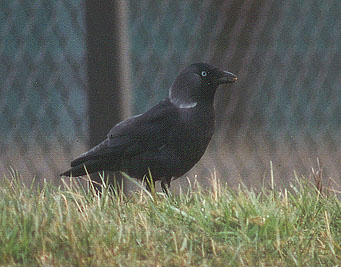
Adult Nordic/Russian Jackdaw Corvus monedula monedula/soemmerringii. Wijster, 20 February 1999
The dark nape and neck-side and the marginal collar are good for Nordic Jackdaw, while the grey-black underparts and the white and sharply defined patch in the lower neck suggest Russian Jackdaw. This could be a bird from the hybridisation zone between Nordic and Russian Jackdaw in eastern Poland. As a consequence this bird cannot be safely identified
.
Occurrence
Status in the Netherlands
If the aforementioned characters are used to define the status of the two eastern races of Jackdaw in the Netherlands, it seems clear that it is different from their status as mentioned in the literature (e.g. SOVON 1987, van Dijk en van Os 1982). From experience in the field I conclude that Nordic Jackdaw is locally a common winter visitor on the higher grounds in the eastern and southern parts of the Netherlands and that very occasionally they are accompanied by a Russian Jackdaw. This conclusion is shared by more recent literature, in which Nordic Jackdaw is called a common winter visitor and Russian Jackdaw a regular but scarce winter visitor in the southern and eastern parts of the Netherlands (Cramp & Perrins 1994, van den Berg & Bosman 1999).
It must be stressed, however, that as many wintering Jackdaws are first year birds, a lot of Nordic and especially Russian Jackdaws will surely be overlooked. Only the obvious individuals with the bright collars are likely to be noticed. The same goes for adult individuals without a pale collar. Russian Jackdaw might well be more common in winter than is currently assumed.
Although low in numbers the occurrence of Nordic Jackdaw also shows in ringing-recoveries in the literature, with recoveries from south Scandinavia and south-west Finland (van Dijk & van Os 1982, Speek & Speek 1984). The occurrence of Russian Jackdaws in the Netherlands has not yet been proven from ringing recoveries.
Occurrence in the Netherlands
The occurrence of both races of Jackdaw in the Netherlands seems largely restricted to the higher (sand)grounds of the east and south. In the lower parts common Jackdaw is much more numerous. In the province of Drenthe in the north-east of the Netherlands groups of Jackdaws (150-600 ind.) can be encountered, which consist for up to 90% of Nordic Jackdaw with rarely a pure Russian Jackdaw. So far the highest count of the latter has been 10 in a group of 530 mostly Nordic Jackdaws.
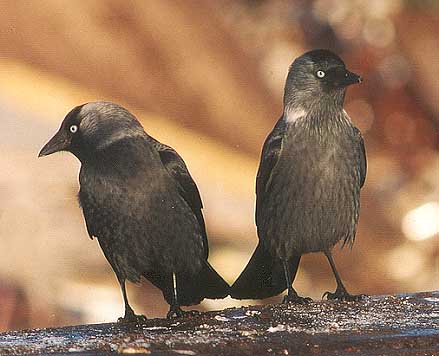
Two Nordic Jackdaws with different toned underparts and collars. Wijster, the Netherlands, 19 December 1999
Discussion
Can every Jackdaw in winter be identified to its specific race? That is the question I wanted to answer before I started this article. Unfortunately, the answer is no. It would be easy if every Nordic and Russian Jackdaw showed a pale collar to such an extent that they could be safely identified on that alone, but this is not the case. Apart from the variation in adults, a large part of the wintering Jackdaws in the Netherlands consists of first-year birds, which cannot be safely identified. The situation is complicated by the fact that the breeding populations in south Finland and east Poland cannot be considered to belong to any of the races and that exactly these birds are likely to show up in our parts. This is why the identification of the various races of Jackdaw is a disputable matter and a brave attempt at best.
In the field, however, I consider it possible to identify not all, but certainly a large part of the wintering Jackdaws. That this identification will sometimes solely be based on the presence or absence of a pale or white collar is inevitable, and will cause a lot of potential eastern Jackdaws to remain unnoticed. The tone of the underparts can serve as a valuable additional fieldmark.
Of the three races, Common Jackdaw and Russian Jackdaw are easiest to identify. All Jackdaws between these two races, with the inclusion of those in the hybridisation zones, could be considered Nordic. Maybe it is best to regard Common and Russian Jackdaw as races and Nordic Jackdaw as a ‘form’.
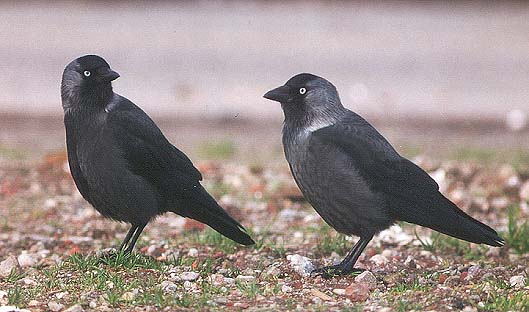
Wijster, 6 February 2000. Right a Nordic Jackdaw, left an unidentifiable type. Both are adults. The bird on the right has too dark underparts for a true Nordic but rather pale earcoverts and a hint of a pale collar in the lower neck. Which goes to show that identifying a single Jackdaw to its specific race can be daunting task…
Acknowledgements
I thank the following persons for contributing to this article: Theo Bakker, Arnoud B. van den Berg, Bert de Bruin, Emo Klunder, Teus Luijendijk, Gerald Oreel, Ale Terpstra and Rik Winters. Special thanks to Kees Roselaar for his guidance at the ZMA and for his comments on this article and to Jan Allex de Roos for critically checking my translation.
References
van den Berg, A B & Bosman, C A W. 1999. Avifauna van Nederland 1. Rare birds of the Netherlands. Haarlem/Utrecht
Cramp, S & Perrins, C M 1994. The birds of the Western Palearctic 8. Oxford.
van Dijk, A J & van Os, B 1982. Vogels van Drenthe. Assen.
Glutz von Blotzheim, U N & Bauer, K M 1991. Handbuch der Vögel Mitteleuropas. Wiesbaden
Jukema, J & Rijpma, U 1997. Populatiesamenstelling van overwinterende Kauwen Corvus monedula in Noord-Friesland. Limosa 70:61-66.
Madge, S & Burn, H 1994. Crows & Jays: a guide to the crows, jays and magpies of the world. London.
SOVON 1987. Atlas van de Nederlandse Vogels. Almelo.
Speek, B J & Speek, G 1984. Thiemes vogeltrekatlas. Zutphen.
Svensson, L 1992. Identification guide to European Passerines. Stockholm.
Voipio, P 1969. Geographical variation in Corvus monedula in Finland. Ardea 57:48-63
Voous, K H 1950. The post-glacial distribution of Corvus monedula in Europe. Limosa 23: 281-292.
Voous, K H 1960. Het voorkomen van Oosteuropese Kauwen (Corvus monedula soemmerringii) in Nederland in de winter 1948-1949. Limosa 33: 128-134.
Ó
Rudy Offereins, Grote Kerkstraat 109 8911 EB Leeuwarden, the NetherlandsBack to the main page